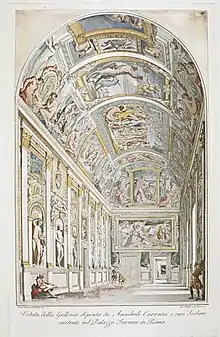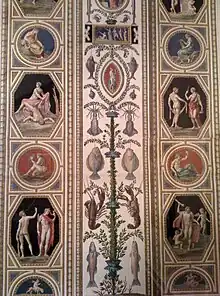_by_Angelica_Kauffmann.jpg.webp)
Giovanni Volpato (1735–1803) was an Italian engraver. He was also an excavator, dealer in antiquities and manufacturer of biscuit porcelain figurines.
Biography
Giovanni Volpato was born in Bassano del Grappa (then part of the Republic of Venice). He received his first training from his mother, an embroiderer, and then studied under Giovanni Antonio Remondini. In 1762 he went to Venice and worked with Joseph Wagner and Francesco Bartolozzi, engraving several plates after Piazzetta, Mariotto, Amiconi, Zuccarelli, Marco Ricci and others. He worked for some time for the Duke of Parma, until a plate of the Monument of Francesco Algarotti in Pisa brought him wider notice.
In 1771, following a suggestion of his patron Girolamo Zulian, he moved to Rome, where he founded a school of engraving and gained a reputation for his series of plates after the frescoes of the Raphael Rooms and Loggias in the Vatican (1770–77). Some of these plates[1] were hand-coloured by Francesco Panini, and did not necessarily reproduce the actual design or subjects of the Loggias' vaults and pilasters, but they became much in demand among visitors to Rome. Volpato made this impressive panorama of Rome based on Francesco Panini's drawings, part of the Rijksmuseum collection:


With the collaboration of Francesco Panini and Lodovico Teseo, on one hand, and, together with Pietro Bettelini, on the other hand, a series of prints after frescoes painted by Annibale Carracci in the Galleria di Palazzo Farnese, were published by Volpato between 1775 and 1777.[2][3][4]
He engraved a series of landscapes and vedute of Rome with Pietro Ducros.
Volpato was a friend of the British painter and antiquarian, Gavin Hamilton. When Volpato himself became an excavator, he supplied Hamilton with some sculptures and engravings for his Schola Italica Picturae, while Hamilton introduced him to clients interested in his findings and publications.
Volpato made excavations in Ostia (1779, with the antiquarian Thomas Jenkins), Porta San Sebastiano (1779) and Quadraro (1780); and sold sculptures to king Gustav III of Sweden (1784), to the Vatican Museums, and to the British collector, Henry Blundell. In 1788 he sold the celebrated Lante Vase to Colonel John Campbell. In 1792, in collaboration with Louis Ducros, he published a series of prints of the interiors of the new Museo Pio-Clementino.[5]
In 1785, he established a porcelain factory that made ceramic replicas of Greco-Roman originals[6] to satisfy the demand for antique art during the Neoclassic period.[7]
In 1789, Volpato collaborated with the architect Giuseppe Panini, brother of Francesco, on commemorative prints of the Santa Maria in Monserrato degli Spagnoli church, on the occasion of the death of Charles III of Spain in 1788.[8]
One of his pupils was his son in law, Raffaello Morghen. Volpato died in Rome.


Among his plates for Gavin Hamilton are:
- Marriage of Alexander and Roxana.
- The four Sibyls; after Raphael.
- Perseus and Andromeda; after Polidoro da Caravaggio
- Modesty ami Vanity; after Leonardo da Vinci.
- Christ praying at the Mount; after Correggio.
- Feast in the house of Simon; after Paolo Veronese
- The Marriage of Cana; after Tintoretto.
- Gamblers after Michelangelo da Caravaggio.
Further reading
- Ilaria Bignamini, Clare Hornsby, "Digging and Dealing in Eighteenth-Century Rome" (2010. Yale U.P.), p. 339-340
- L. Melegati, "Giovanni Volpato e il cantiere romano", in Ricordi dell'antico: sculture, porcellane e arredi all'epoca del Grand Tour, ed. A. d'Agliano, L. Melegati [exhibition catalogue, Musei Capitolini, Rome] (2008), p. 101-114
- F. Haskell, "The Museo Pio-Clementino in Rome and the Views by Ducros and Volpato", in Louis Ducros: Images of the Grand Tour [exhibition catalogue, Kenwood House, London] (1985), p. 36-39
- C. Faccioli, "Anni ed Epistolario romano d'un grande incisore bassanese, Giovanni Volpato", in L'Urbe; 32:3 (1969), p. 18-35
- H. Honour, "Statuettes after the antique: Volpato's Roman porcelain factory", in Apollo; 85 (1967 May), p. 371-373
- Bryan, Michael (1905). Williamson, George C. (ed.). Bryan's Dictionary of Painters and Engravers, new edition revised and enlarged. Vol. V: S-Z. London: George Bell and Sons. p. 320.
- Hind, Arthur (1963). A History of Engraving & Etching, from the 15th century to the year 1914. New York: Dover Publications, INC. pp. 209, 364.
- Dacos, Nicole (2008). The Loggia of Raphael, a Vatican art treasure. Libreria Editrice Vaticana, Abbeville Press Publisher. pp. 318–320.
- Marini, Giorgio; Volpato, Giovanni (1988). "Giovanni Volpato: 1735-1803" (Italian Edition). [Exhibition catalogue: Museo-Biblioteca-Archivio, Bassano del Grappa, Jan. 19-Apr. 10, 1988 and the Istituto Nazionale per la Grafica, Gabinetto Disegni e Stampi, Apr. 22-June 22, 1988]. Bassano del Grappa: Ghedina & Tassotti edit. ISBN 9788876910357
References
- ↑ "Loggie di Rafaele nel Vaticano | Musées d'art et d'histoire de Genève". Musée d’art et d’histoire de la Ville de Genève (in French). Retrieved 2023-04-25.
- ↑ "print :View of the north side of the Farnese Gallery with the frescoes of Annibale Carracci. 1775-7 | British Museum". The British Museum. Retrieved 2023-04-26.
- ↑ Panini, Francesco. "Résultats de la recherche". Musées d'art et d'histoire de Genève (in French). Retrieved 2023-04-29.
- ↑ "Rome, Palazzo Farnese: paintings of the loves of the gods by Annibale Carracci. Engraving by P. Bettelini and G. Volpato after A. Carracci, ca. 1800". Wellcome Collection. Retrieved 2023-04-26.
- ↑ F. Haskell, 'The Museo Pio-Clementino in Rome and the Views by Ducros and Volpato', in Louis Ducros: Images of the Grand Tour [exhibition catalogue, Kenwood House, London] (1985), p.36-39.
- ↑ "Centaur with putto". collection.nationalmuseum.se. Retrieved 2023-08-06.
- ↑ H. Honour, 'Statuettes after the antique: Volpato's Roman porcelain factory', in Apollo; 85 (1967 May), p.371-373.
- ↑ Volpato, Gianni; Pannini, Giuseppe (1789). "print of "Perfil de la Yglesia de Santiago de los Españoles de Roma en las Honras del Rey Carlos III" | British Museum". The British Museum. Retrieved 2023-04-26.
External links
- The River Nile porcelain piece at the Metropolitan Museum.
- The Roman Lante Vase, at the Woburn sculpture gallery, originally found at Hadrian's Villa